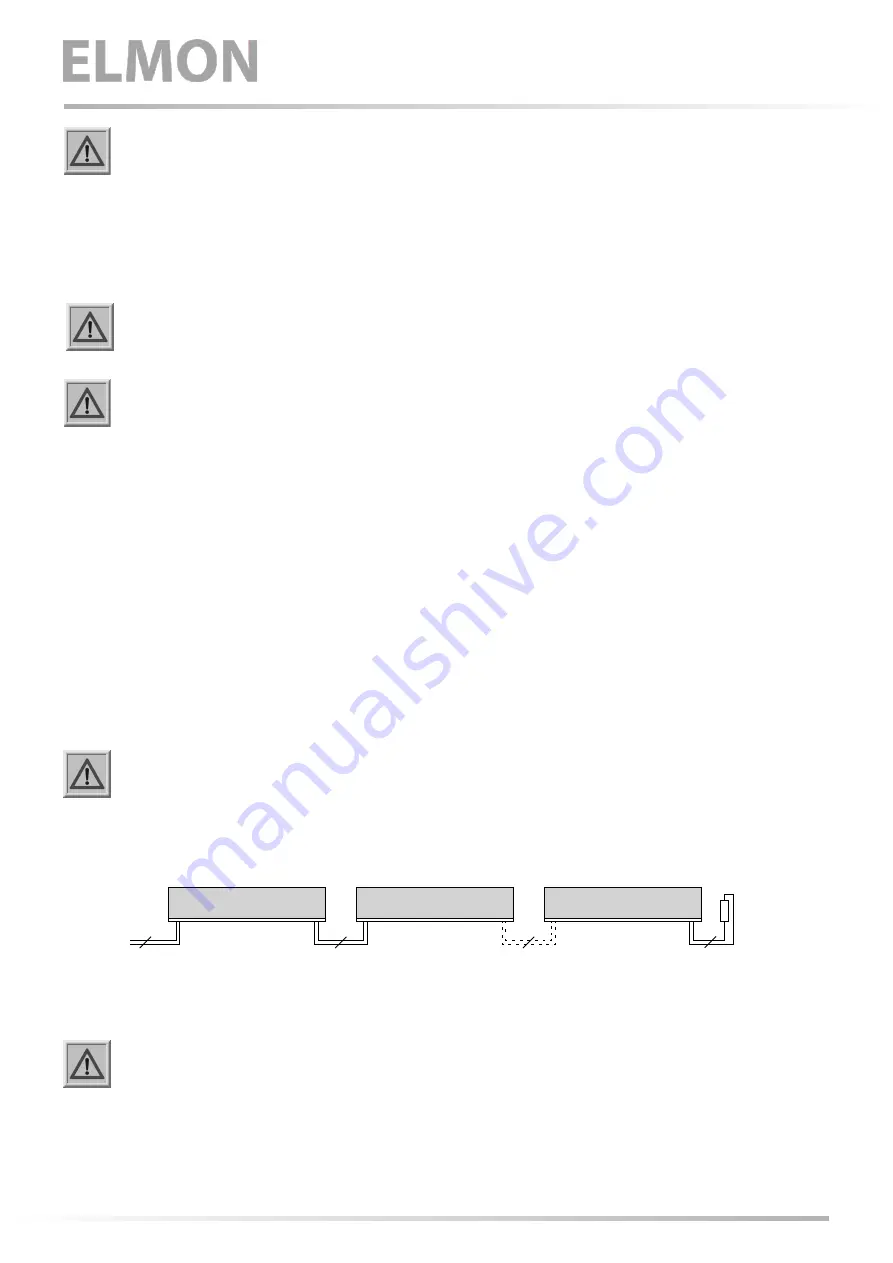
2
Elektrischer Anschluss
Verlegung der Signalleitung darf nicht parallel zur Motorleitung oder anderen Leistungsleitungen erfolgen.
Leitungen, die im Freien oder außerhalb vom Schaltschrank verlegt werden, müssen entsprechend geschützt werden.
Die für das Gerät angegebene Schutzart ist nur dann sichergestellt, wenn die Zuleitungen ordnungsgemäß in die Verschraubungen geklemmt sind.
Der Anschluss an die falschen Klemmen kann das Schaltgerät zerstören.
Die in den „Technischen Daten“ angegebenen Grenzwerte für die Versorgungsspannung und Schaltvermögen des Relais sind zu beachten.
Electrical connection
The signal cable must not be placed parallel to the motor cable or other power cables.
Cables installed outdoors or outside of the switching cabinet must be protected appropriately.
The protection class specified for this device is only ensured if the supply lines have been properly clamped to the screw connections.
Connecting to the wrong terminals can destroy the switching unit.
The limit values for the supply voltage and the switching capacity of the relay specified in the „technical specifications“ are to be observed.
Sorgen Sie an allen Ausgangskontakten bei kapazitiven und induktiven Lasten für eine ausreichende Schutzbeschaltung.
Sufficient fuse protection must be provided on all output contacts with capacitive and inductive loads.
Versorgungsspannung
Die Spannungsversorgung kann
wahlweise
mit Netzspannung 230 V AC 50/60 Hz oder mit Kleinspannung 24 V AC/DC erfolgen. Bei Versorgung mit
24 V AC/DC, muss die Spannung den Anforderungen für Schutzkleinspannung (SELV) entsprechen. Die Versorgungsleitung zum Schaltgerät ist mit
einer passenden Sicherung zu schützen.
Niemals beide Spannungen gleichzeitig anlegen!
Die 230 V Versorgungsspannung ist an die Klemmen
L1 und N
anzulegen. Versorgungsspannung 24 V an die Klemmen
24 V AC/DC anschließen.
Supply voltage
The supply voltage can optionally be effected by means of a mains voltage of 230 V AC 50/60 Hz or a low voltage of 24 V AC/DC. For a supply with
24 V AC/DC the voltage must correspond to the requirements for protective low voltages (SELV). The supply line to the switching device must be
protected by means of a suitable fuse.
Never apply both voltages simultaneously!
The 230 V supply voltage must be applied to the
L1 N
terminals. For operation with 24 V, the supply voltage must be connected to the
24 V AC/DC
terminals.
Anschluss des Signalgebers
Den Signalgeber für Kanal1 an das Klemmenpaar
STATIONARY Opening
anschließen. Den Signalgeber für Kanal2 an das Klemmenpaar
STATIONARY Closing
anschließen.
Sollte ein Kanal nicht genutzt werden, muss dieser mit einem 8,2 kΩ Widerstand belegt werden.
Connection of sensor
Connect the sensor for channel 1 to terminal pair
STATIONARY Opening. Connect the sensor for channel 2 to terminal pair STATIONARY Closing.
If a channel is not used, it must be connected to an 8.2 kΩ resistor.
Anschluss von mehreren Signalgebern pro Signalgeberkreis
ASO-Signalgeber dürfen nicht parallel geschaltet werden.
An dem Signalgebereingang können ein oder mehrere Signalgeber angeschlossen werden. Hierfür werden die einzelnen Signalgeber in Serie geschaltet (Bild 1).
Connection of several sensors per sensor circuit
ASO-Sensors must not be connected in parallel.
One or several sensors can be connected to the signal transmitter input. For this purpose, the individual sensors are connected in series in accordance with
Figure 1.
Anschluss Steuerstromkreise
An das Klemmenpaar
STOP Opening
ist der zu überwachende Steuerstromkreis für die Auf-Bewegung (Kanal 1, Stop-Auf-Bewegung) und an das Klemmenpaar
STOP Closing
der entsprechende Steuerstromkreis für die Zu-Bewegung (Kanal 2, Stop-Zu-Bewegung) anzuschließen.
Der Anschluss für die Steuerkreise ist nur zum Schalten von Kleinspannungen zugelassen. Die Steuerstromkreise sind abhängig vom Nennstrom mit
einer entsprechenden Sicherung zu schützen, oder der Nennstrom auf den Steuerstromkreisen muss durch andere Maßnahmen auf den maximalen
Wert begrenzt werden.
Connection of control circuits
The control circuit to be monitored for the opening movement (channel 1, stop-opening movement) is to be connected to the
STOP Opening
terminal
pair; for the closing movement (channel 2, stop closing movement), the appropriate control circuit is to be connected to the
STOP Closing
terminal pair.
The connection for the control circuits is permitted only for switching low voltages. The control circuits are dependent on the rated current to protect with
an appropriate fuse or the rated current to the control circuits must be limited by other measures to the maximum value.
Bild 1: Verschaltung mehrerer Signalgeber, hier am Beispiel Sicherheitskontaktleiste
Fig. 1: Interconnecting several sensors, here using the example of the safety contact edge
O
C
Signalgeber „n“
Sensor „n“
Signalgeber 1
Sensor 1
Signalgeber 2
Sensor 2
2
2
2
2
Sicherheitsschaltgerät /
Safety Relay






















